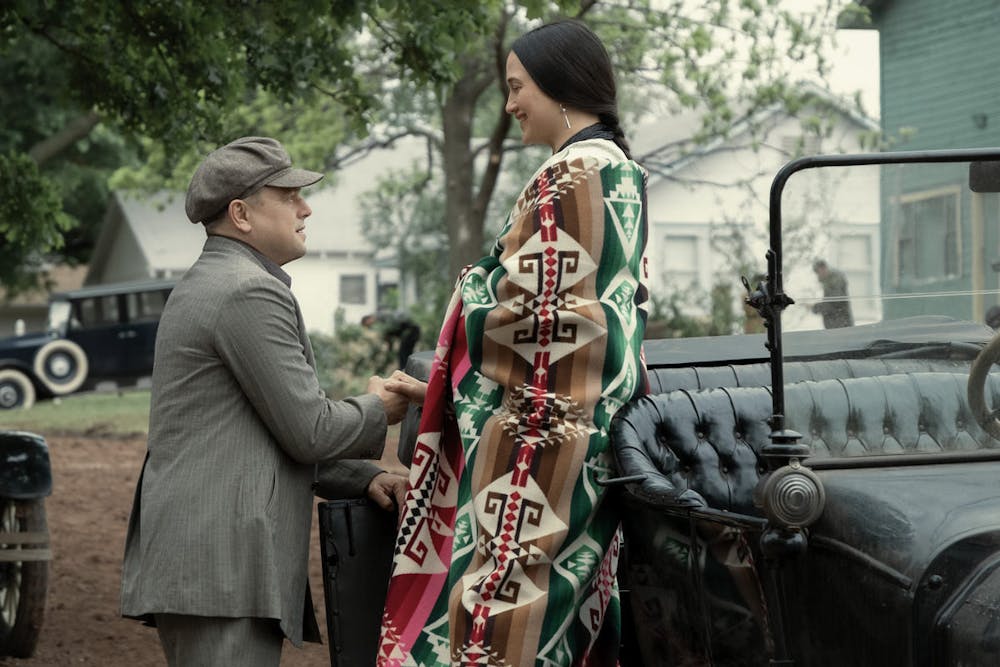It’s rare to sit down for a movie fully assured that it will be a monumental work of cinema. It’s even rarer for that film to be made by — in my opinion — the greatest American filmmaker who’s ever lived. But such is the case with “Killers of the Flower Moon,” the nearly three-and-a-half-hour long epic from Martin Scorsese about a string of murders committed against members of the Osage tribe in the 1920s and the federal investigation that followed.
As the film explains, the Osage during this time were the wealthiest people per capita in the United States — a result of their land containing copious amounts of oil. But when money comes rushing in, so do outsiders — including William “King” Hale (Robert De Niro), a successful cattle rancher and so-called “friend” of the Osage people. His nephew Ernest Burkhart (Leonardo DiCaprio) has just returned from World War I and moved in with his uncle to start a new life.
Burkhart becomes a cab driver in town, and picks up Mollie Kyle (Lily Gladstone), a member of a prominent oil owning Osage family, who becomes a frequent client. With the heavy-handed encouragement of Hale, Burkhart starts a romance with her while Hale’s more sinister intentions slowly come to light. As this romance blooms, members of the Osage begin dying in mysterious circumstances one by one — including members of Kyle’s family.
It seems needless to remark that a Martin Scorsese film is well directed, yet Scorsese is so profoundly good at what he does that he never ceases to amaze even the most well-seasoned audiences with his complete mastery of the craft. For over 50 years, Scorsese has been at the peak of the cinematic mountaintop, never once losing his footing in that position — the only person who has shown to be able to surpass Scorsese is Scorsese himself.
What makes Scorsese stand out above the rest of the pack is the daringness with which he makes every move. Scorsese is unafraid to put bad people front and center in his work, whether it be Travis Bickle in “Taxi Driver” or Jordan Belfort in “The Wolf of Wall Street.” William Hale and Ernest Burkhart are no different — played by the same two respective actors no less. These are corrupt, despicable individuals, but Scorsese will never explicitly tell you that.
Rather, he takes the method — that is more difficult to pull off but all the better if done correctly — of allowing the audience to sit and marinate in this despicableness — to see it in all its permutations and effects but always through the characters’ ideologically clouded worldview. It is incumbent upon the audience to wade through the bogs of these characters’ minds and find the truth that exists somewhere within them. If one thing is certain, Scorsese will never spoon-feed you a simple answer.
That leads to another crucial element of Scorsese’s entire filmography — the dark side of the American dream. Scorsese has always told uniquely American stories about uniquely American individuals — not in their exploration of freedom, liberty and equality, but in their highlighting of corruption, cruelty and greed.
Under that model, “Killers of the Flower Moon” is one of the most Scorsese films he has ever made. Cruelty and greed flow through this movie like the oil flowing through the Osages’ pipes. It slowly creeps up through the magical work of Scorsese’s careful filmmaking hands. As the film progresses, you can gradually see the foreign presence in Osage land begin to populate their towns and homes. It is never directly commented on, but it is always made known. You can see how the prospect of riches tears families and communities apart and completely desecrates once-sacred spaces. And most crucially, you see the pain of those caught in the crossfire of these games of wealth and status.
“Killers of the Flower Moon” is a film which in lesser hands would be a by-the-books whodunnit shrouded in fake mystery and shallow thrills. What Scorsese does is immediately revert the audience’s expectations by laying everything out very immediately. You know who is doing the murders fairly quickly and you know why they’re doing them. You know who’s lying and who’s telling the truth. With all this out in the open, there is space for more interesting things to be said. There is time to understand these characters not just as they appear on the surface, but also on a psychological level. There is time to fully understand the cruelty of what was done to the Osage people and grapple not only with what that meant then, but what that means today.
Bearing witness to a Scorsese film in theaters is not just a monumental event isolated to the world of film, it is monumental to the history of art as a mode of expression. It is crucial to cherish every moment he brings to the screen, as there are few cut from his same cloth left standing. And even though the film is well over three hours, not a moment of it feels wasted.

Finn Kirkpatrick was the senior editor of multimedia of the Brown Daily Herald's 134th editorial board. He is a junior from Los Angeles, California studying Comparative Literature and East Asian Studies. He was previously an arts and culture editor and has a passion for Tetris and Mario Kart.





